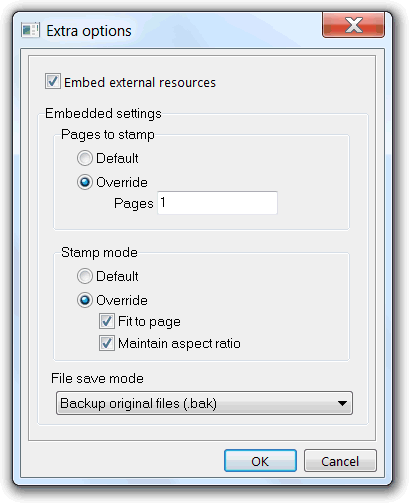This tool is used to stamp text, raw images and geometric shapes, on PDF pages. It is ideal to stamp the company logo or information stamps like "Draft", "Confidential", "Copy" in our PDF's. The tool GUI provide visual creation of the final stamp object, than can aggregate many basic objects as: text, raw images, geometric shapes, or even other PDF's pages.
The GUI Stamps tab sheet is used to compose the stamp template by combining different stamp objects. The final stamp, the one that will be stamped onto the PDF's pages, can be as simple as a text only object, or a composition involving more of the same type, or different, stamp objects. There is the possibility to save the stamp template so it can be use later for other stamp operations.
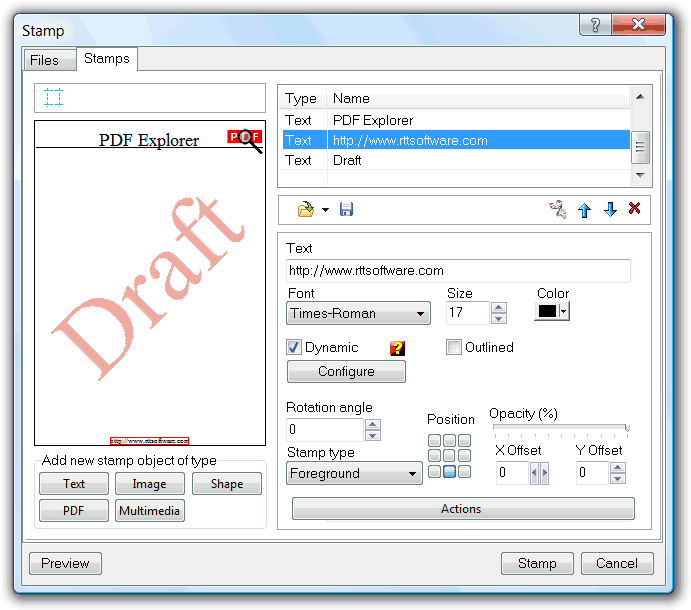
The available stamp objects are of type:
The stamp composition is done adding, and positioning, stamp objects with the help of a basic WYSIWYG (What You See Is What You Get) interface, representing an A4 media page size. Different stamp type objects have different properties panels to define the way the object will look in the final stamp. Size, scale and colors are some examples of these properties. In the above screenshot image, the text stamp object properties panel is visible.
All the stamp objects have some properties that are common, but not shared, to all. They are:
Some properties, as scale and size, behave differently from common sense, when setting these values to zero. This specific value instruct the tool to consider that value as the page width/height, or scale the object to these page extents.
Object layering rules are used when more than one stamp object is in use. Front objects hide back objects. The layer order can be changed, changing the object position in the list of stamp objects.
The margins tool, invoked by the ![]() tool button, is used to add margins to the stamped page. Provides a way to add blank space where the stamp can be positioned, when there is a need to that space. The margins will affect only the page contents, do not interfere with the stamp object position.
tool button, is used to add margins to the stamped page. Provides a way to add blank space where the stamp can be positioned, when there is a need to that space. The margins will affect only the page contents, do not interfere with the stamp object position.
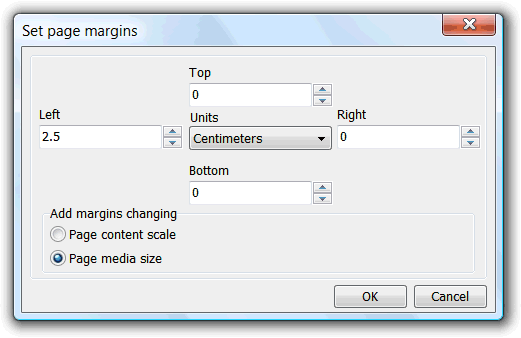
There are two possibilities to add margins to the document page. By scaling the page contents, or changing the page media size.
The first option will add the specified margin by scaling the content, already in the page to be stamped. This option maintains the page media size but will distort the contents if specified margins are different from each other.
The second option is more secure as extra space is added by resizing the page media size itself.
Visual aids are displayed in the WYSIWYG interface to help in the position of the stamp objects.
When a text object is configured to be treated as a dynamic text object, by checking the dynamic check box of the text object properties panel, this will instruct the tool to interpret the next mentioned bracket enclosed constants as references to dynamic text objects output.

These constants will be replaced by the referenced dynamic text object output at time of the stamping operation.
Only the bracket enclosed references are interpreted as dynamic. Stamp text object composition can include static text too. e.g. Stamped [D] at [T] by [U]
The [X#] constant reference a powerful dynamic object. This object is able to gather external applications console text output as source of this object text output. Configured in the Dynamic Text Settings, see below, the # has to be replaced by the configured external application index ( [X1], [X2], etc.).
This object can call the configured external application passing, as parameters, the filename, and, actual to stamp, page number, of the document being stamped. This info can be used by the external application to query databases, or any other fancy operation, in order to generate the text to stamp.
The dynamic text object properties panel "configure" button provides access to the Dynamic Text Stamp Settings Dialog.
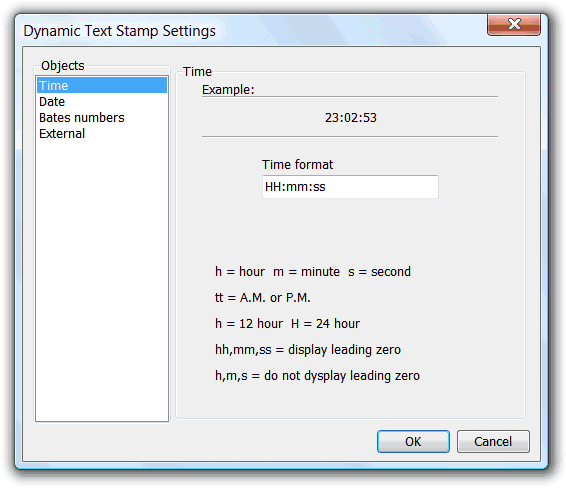
This dialog is used to configure the diverse dynamic text objects settings. Can be used to define the Time and Date format, Bates numbers properties, and External applications linkage.
This settings are saved with the stamp template. Other saved stamp templates can have different settings.
This dialog is used to define the main settings of the multimedia object. It's a dynamic dialog, that changes with the type of multimedia the top file path or URL edit field refers. This field can point to local or Internet remote content, of type Flash SWF animations, MP3 audio, Flash FLV's and H.264 video, YouTube and Vimeo URL's.
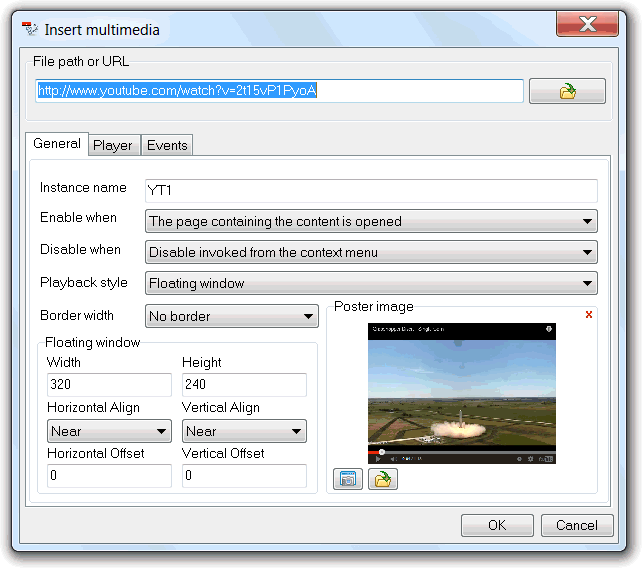
The main general tab is always present and unchanged, despite the multimedia type. It's used to define how the multimedia content will be played and interfaced from the PDF page and reader.
The instance name field is used to identify the object instance and is only needed for PDF JavaScript scripting.
How the multimedia starts and stops playing is defined with the enable when and disable when selectors. The utilization is simple, but the selected choices may impact the PDF reader resources usage. As example, for an animated logo, that is going to be placed in all the pages, the enable should be set for when the page containing the content is visible, and the disable for when the page is not visible, so to keep the reader related resource usage optimized.
The playback style defines if the multimedia plays embedded in the page (in the insert bounding box), if in a floating window or if hidden. The hidden option is useful to add background music to the PDF. When set to floating window, the position and size of the windows can be defined from the floating window options group.
The floating window options group width and height fields define the width and height of the floating player window. The horizontal align and vertical align field set the main position of this window, related to the top left or top right corners of the PDF reader application. The referred corner is defined by the current document left-to-right or right-to-left text reading order. The horizontal offset and vertical offset fields can be used to shift the main selected align position.
The poster image option is used to specify an image to shown in the page, in place of the multimedia for when the multimedia is not active/playing. It is also this image that will be used if the containing page is printed. Usually it is a snapshot of the multimedia itself, so there is a tool to play and grab snapshots, accessible from the take snapshot button, but any other representation may be used so there is also a button to select an external image file. This poster image can be further enhanced with a border, from the border width selector. This poster image should not be specified when the playback style is set to hidden, as in this situation there isn't, usually, any need to have a visual reference to the multimedia in the page area.
All the other settings tabs are dynamic and related to the content being inserted. For audio and video there is a tab named player, where it is possible to define some player settings, and setup playlists. For Flash SWF's there is a SWF tab, from where to specify the usual flashvars parameter, and a resources tab to enter external or remote files resources the SWF needs.
The events tab is used to specify JavaScript functions that will run in response to various of the scriptable events each file type player exposes. Events such as onPlay, onStop, or specific to the SWF being played, can be used to automate actions in the PDF presentation. It is in this case that it is mandatory to specify the instance name referred above, or the player will not be able to identify what script to call for each of the triggered events.
This editor is used to add, and edit, event actions assigned to a stamp object, such as launch a web link, or run a javascript.
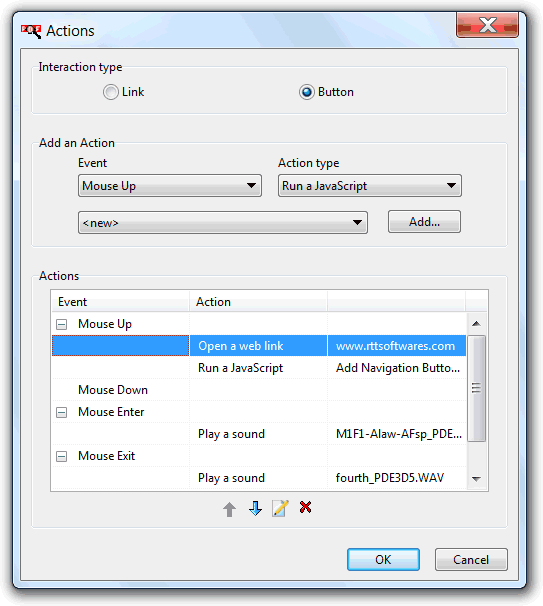
There are two possible interaction types, Link and Button. This defines what type of method will be used to capture the events. The link type can only respond to click events, and is the more suitable to launch web links, while the button type can respond to a more diverse type of events.
Each stamp object can have more than one action assigned, for the same or different event types.
To add an action there is only the need to select the type of action, the type of fire event when the interaction type is button, and click the add button. The combo box at the left of the add button shows a repository of saved, or last used, settings for the type of action selected, that can be used to easily enter a previously used/saved action.
After setting the action parameters, in its specific action editor, a new action will show in the list of actions. This list can then be used to edit the action again, and, more important, to define its order of execution when more than one action is assigned to the same event type.
The "run a JavaScript" action type is specially powerful, but its usage requires knowledge of the specificities of the PDFs JavaScript. At this page, there is plenty of information about the Acrobat Javascript API (that may not be fully supported by other PDF readers), and many other very useful related resources.
The Files tab sheet is used to check the files that are going to be submitted to the stamp operation, define the documents pages to stamp, and to specify the stamp mode and stamped file save mode options.
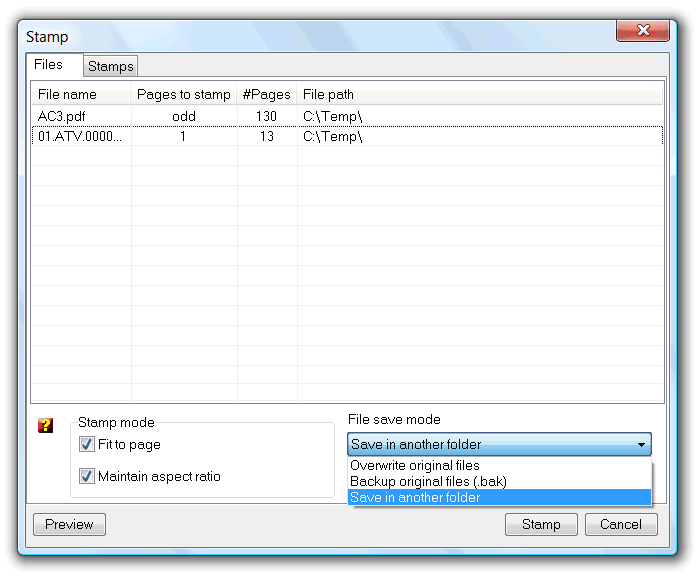
By default, all the documents pages are selected to be stamped, but the Pages to stamp column fields can be edited to custom define what pages to stamp, using the following rules:
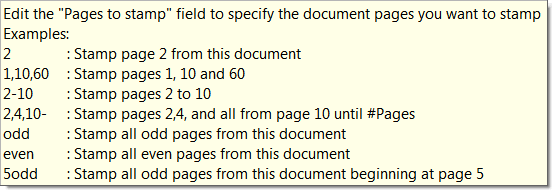
The preview button uses the list selected file as file to stamp preview, so, to check how the current stamp template will look like when stamped onto a specific file, just make sure that file is selected before clicking the preview button.
The stamp template is defined for an A4 page size, the one represented in the WYSIWYG output. The stamp mode options define how to behave when stamping pages with different sizes. The fit to page option will scale the stamp, up or down, in order to maintain proportionality to the designed stamp template. If the Maintain aspect ratio option is also checked, only the X scale proportionality is maintained, sacrificing the Y scale but maintaining the aspect ratio of the designed stamp template. Design scale will be used if Fit to page option is unchecked.
The file save mode selector define if the stamped file override the source file, if a backup unstamped file is created, or if user must be asked for an output folder where to put the stamped files.
This settings always assume the last used, or default, values, but can be differently imposed by stamp template, defining them on the save template extra options dialog. This extra options dialog is accessible from the Options button found at the save dialog.
